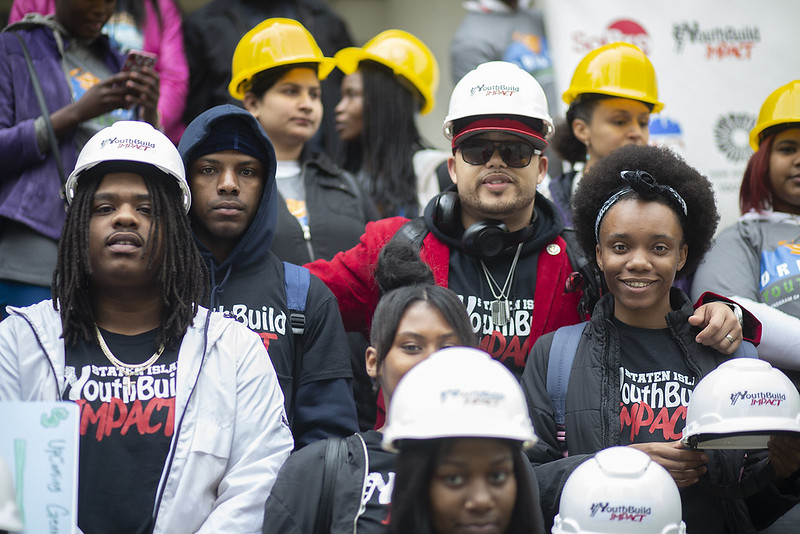
Youth employment programs at work (photo: William Alatriste/City Council)
A 2021 report by the city warned that up to 25% of New Yorkers aged 18-24 were at risk of becoming “disconnected,” meaning neither working nor attending school. And indeed, nearly 18% of young New Yorkers are unemployed, with rates for young men and women of color even higher. So it was alarming to read reporting from Gotham Gazette last week that the city’s programs to combat youth unemployment are under-enrolled and unable to expand to meet the need.
But even as elected officials, service providers, and workforce development experts grappled with this seeming disconnect, they neglected one resource that could play a significant role in solving this problem: high schools.
We have seen this problem up close. By most traditional metrics, MESA Charter High School, which we co-founded, has been a success. A non-selective school where students are admitted by lottery and over 85% are classified as “low-income,” MESA graduates 93% of its students on time, far outpacing the city average. Yet too often, our alumni struggle after graduation.
Despite meeting “college readiness” benchmarks, our students still graduate onto a razor’s edge. The slightest setback — a cut in a parent’s wages that impacts their ability to pay for college, a bureaucratic slip-up at a university, a missed payment deadline — can lead to disaster. Students drop out and wind up either unemployed or in low-wage, dead-end jobs.
So two years ago we honed in on supporting our “disconnected” alumni, either by helping them re-enroll in college or matriculate into a free, non-profit workforce program that led to a high-quality job. This year, we formally launched our Alumni Lab, a six-week bootcamp that works with alumni on a variety of topics, some as broad as developing a growth mindset and financial literacy to others as specific as resume writing and interview coaching. We’ve had 30 alumni go through the program thus far, and 70% have either returned to college or matriculated to a high-quality workforce development program in fields such as tech, medical professions, building trades, culinary arts, or business and entrepreneurship.
As Adams administration officials told the City Council last week about their own programs, the greatest challenge is getting young people to join ours in the first place. Students have been taught that success means seamlessly moving from high school to college to career; popular culture and social media often reinforce that narrative. When a student falls off track–as many do–they feel a sense of failure and shame. Many of our alumni have described feeling embarrassed that they had “let down” their parents, their teachers, and themselves.
The key to overcoming that shame? The relationship with their high school.
We’ve known these young people and their families for years, in some cases for a decade. Almost to an individual, they will describe the positive, supportive environment they experienced while at MESA. Accepting support like the kinds being offered by workforce development programs also requires vulnerability, an acknowledgement that one has fallen off track somewhere along the line. Understandably, young people are much more likely to open themselves up this way to an institution that they have years of trust with than to a bunch of strangers.
The best way for city workforce programs to fill their seats would be to partner with high schools.
“Disconnected Youth” are, by definition, hard to reach. But 75% of them have a high school diploma, which means they have a relationship with at least one institution. Additional funding to high schools to support their alumni after graduation could create a smooth pathway from high school to post-secondary programs, as well as a stronger safety net when students struggle after graduation. Because of the pre-existing relationships between schools, students, and families, the school is also better situated to provide the follow-up and continued support that everyone agrees students need to be successful.
Bringing high schools into the fold makes economic sense, too. Thanks to some generous philanthropic contributions, we’ve been able to run our program on just over $2,000 per student. Next year we hope to expand the number of kids served and partner with a few other high schools, which will bring the cost below $1,400 per child.
According to the 2021 New York City report, the fiscal burden on taxpayers of each disconnected youth is $16,000 annually. Given the city’s estimate of over 100,000 disconnected youth, investment in a partnership with high schools could yield hundreds of millions in savings.
While the news that program slots are going unfilled is disheartening, the good news is that there are high-quality programs out there ready to work with young people who are teeming with potential. The city faces several deep, intractable problems, but this one is fixable. Partner more with high schools, and watch the programs fill up.
***
Pagee Cheung and Arthur Samuels are the Co-Founders & Co-Executive Directors of MESA Charter High School in Brooklyn.
***
Have an op-ed idea or submission for Gotham Gazette? Email This email address is being protected from spambots. You need JavaScript enabled to view it.